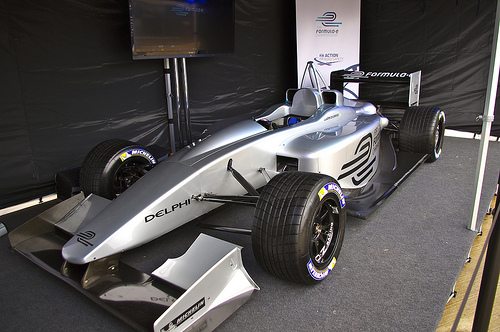Give brand new Formula E a chance
In September of next year a new category of single seater racing, Formula E, will launch globally. This race series is designed to promote the use of green energy and sustainability in racing, a key component of motorsport’s future.
The Formula E car is not too dissimilar in appearance to the Formula One cars that motorsport fans are used to. However, underneath the aerodynamic bodywork lies a new kind of beast: the 200kW battery-powered electric motor providing significant torque (turning force) for zero emissions. Electric motors most often have plenty of torque at the bottom end: however, they also carry a tendency to have a less than impressive top speed.
What is the difference then? The most striking distinction is one brand new concept that will be joining the sport. During the race, fans can communicate via their Smartphone and vote for their favourite driver for them to gain an extra boost during the second half of the race – similar to KERS now, but more of a ‘KERS popularity contest.’
Although this may detract from the pure racing that the majority of us motorsport fans desire, it does allow for another level of spectator participation and influence. Imagine this feature implemented in the current F1 season. Would Sebastian Vettel still dominate? The boos and jibes directed at him would suggest not. Perhaps Kimi Raikkonen or Lewis Hamilton would have a shot at snatching the titles off the four-time world champion.
It is interesting to see this feature start and develop with a whole grid of fresh faces, teams, cars, and rivalries.
This also begs the question: should a Formula One race be a popularity contest? Many of the great racing drivers of the decades, such as Alain Prost and more recently Vettel, have claimed multiple titles despite being ostensibly unpopular on the grid. The possibility of talented drivers not achieving their full potential takes us even further away from a pure sport: however, many will back the new idea as it reflect the fan’s desire within a race.
Branded the ‘Milk Float Challenge’ by various Formula One journalists, Formula E has its fair share of critics
Aside from the spectacular technology, the race calendar is set to feature ten cities across the globe, with drivers competing on temporary street circuits. The main event of the calendar is likely to be the race in glamorous Monaco, with races will also taking place in London, Miami, LA, Hong Kong and Berlin to name a few.
Ten teams will fight it out on the grid, including famous names such as Super Aguri and Andretti Autosport. The suppliers are also linked with current high profile racing teams. For example, the 200kW batteries are provided by Williams Advanced Engineering, and the chassis will be developed by the GP2 and GP3 manufacturer Dallara.
Not only will the teams and circuits be familiar, but also the drivers. Ex Williams F1 driver Bruno Senna is rumoured to be on the grid, joined by the reputable Lucas Di Grassi. Di Grassi piloted a Virgin Racing car in the 2010 Formula One championship, and also gained a reputation as a talented driver at the 2012 Le Mans race in which he finished third.
Furthermore, the race weekend format will be similar to what we are used to in Formula One, with free practice followed by qualifying then the real show – the race. However, rather than a race weekend, it will be compressed into one day allowing the short race distances and single-day format to make for an intense day of viewing for fans. Races will only be around 45 minutes, with two pit stops for each driver to change cars (due to battery life) incorporating a 100m run to their second car during the switch.
With Formula One regulations for 2014 forcing a change from the 2.4L V8 to a 1.6L V6, it may be said that the top formula is heading towards the use of greener technology. With the electric boost also having a much larger influence in lap times and performance it is clear to see that Formula One is adapting for sustainability, driven mostly by FIA regulation changes.
Therefore, with Formula E allowing focus solely on electric vehicle racing technology, it will allow various developments and innovations to be carried through to Formula One, helping the sport become more sustainable, efficient and improving its public image.
Branded the ‘Milk Float Challenge’ by various Formula One journalists, Formula e has its fair share of critics. Sebastian Vettel, made it clear that he isn’t a fan. ’It’s not the future. I think the people come here to feel Formula One and there’s not much to feel when a car goes by and you don’t hear anything else but the wind,’ opined the German.
It may be clear to some that we cannot expect the performance or sheer excitement of a Formula One car in the series’ first year; with the roar of a V8 engine also missing we may be led to believe that Formula E makes for a dull race.
Whichever way motorsport fans react to Formula E, there is no doubt that it will have a large influence on the future of single seater racing, and so should be observed and given a chance by the public. With familiar faces and teams, Formula E is bound to bring in a sizeable crowd, and along with crowds come sponsorships to finance technological development in the ever-changing world of motorsport.

Comments